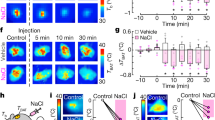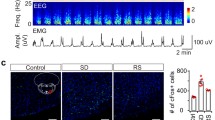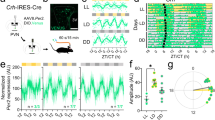Abstract
Osmoregulated vasopressin release is facilitated during the late sleep period (LSP) to prevent dehydration and enuresis. Previous work has shown that clock neurons in the suprachiasmatic nucleus (SCN) have low firing rates during the LSP, but it is not known how this reduced activity enhances vasopressin release. We found that synaptic excitation of rat supraoptic nucleus neurons by osmosensory afferents is facilitated during the LSP. Stimulation of the SCN at this time inhibited excitatory synaptic currents induced in supraoptic neurons by activation of osmosensory afferents. This effect was associated with an increased rate of synaptic failures and occurred without changes in frequency facilitation, quantal size or in the ratio of postsynaptic responses mediated by AMPA and NMDA receptors. We conclude that clock neurons mediate an activity-dependent presynaptic silencing of osmosensory afferent synapses onto vasopressin neurons and that osmoregulatory gain is enhanced by removal of this effect during late sleep.
This is a preview of subscription content, access via your institution
Access options
Subscribe to this journal
Receive 12 print issues and online access
$209.00 per year
only $17.42 per issue
Buy this article
- Purchase on Springer Link
- Instant access to full article PDF
Prices may be subject to local taxes which are calculated during checkout








Similar content being viewed by others
References
Bicknell, R.J. Optimizing release from peptide hormone secretory nerve terminals. J. Exp. Biol. 139, 51–65 (1988).
Bourque, C.W. Central mechanisms of osmosensation and systemic osmoregulation. Nat. Rev. Neurosci. 9, 519–531 (2008).
Robertson, G.L., Shelton, R.L. & Athar, S. The osmoregulation of vasopressin. Kidney Int. 10, 25–37 (1976).
Forsling, M.L. Diurnal rhythms in neurohypophysial function. Exp. Physiol. 85, 179S–186S (2000).
Miller, M. Nocturnal polyuria in older people: pathophysiology and clinical implications. J. Am. Geriatr. Soc. 48, 1321–1329 (2000).
Granda, T.G., Velasco, A. & Rausch, A. Variations and interrelation between vasopressin and plasma osmolality in diabetic rats with insulin treatment. Life Sci. 63, 1305–1313 (1998).
Gordon, C.R. & Lavie, P. Day-night variations in urine excretions and hormones in dogs: role of autonomic innervation. Physiol. Behav. 35, 175–181 (1985).
Claybaugh, J.R., Sato, A.K., Crosswhite, L.K. & Hassell, L.H. Effects of time of day, gender, and menstrual cycle phase on the human response to a water load. Am. J. Physiol. Regul. Integr. Comp. Physiol. 279, R966–R973 (2000).
Richard, D. & Bourque, C.W. Synaptic control of rat supraoptic neurones during osmotic stimulation of the organum vasculosum lamina terminalis in vitro. J. Physiol. (Lond.) 489, 567–577 (1995).
Ciura, S. & Bourque, C.W. Transient receptor potential vanilloid 1 is required for intrinsic osmoreception in organum vasculosum lamina terminalis neurons and for normal thirst responses to systemic hyperosmolality. J. Neurosci. 26, 9069–9075 (2006).
Vivas, L., Chiaraviglio, E. & Carrer, H.F. Rat organum vasculosum laminae terminalis in vitro: responses to changes in sodium concentration. Brain Res. 519, 294–300 (1990).
Trudel, E. & Bourque, C.W. A rat brain slice preserving synaptic connections between neurons of the suprachiasmatic nucleus, organum vasculosum lamina terminalis and supraoptic nucleus. J. Neurosci. Methods 128, 67–77 (2003).
Maywood, E.S., O'Neill, J.S., Chesham, J.E. & Hastings, M.H. Minireview: The circadian clockwork of the suprachiasmatic nuclei—analysis of a cellular oscillator that drives endocrine rhythms. Endocrinology 148, 5624–5634 (2007).
Reppert, S.M. & Weaver, D.R. Coordination of circadian timing in mammals. Nature 418, 935–941 (2002).
Brown, T.M. & Piggins, H.D. Electrophysiology of the suprachiasmatic circadian clock. Prog. Neurobiol. 82, 229–255 (2007).
Kent, J. & Meredith, A.L. BK channels regulate spontaneous action potential rhythmicity in the suprachiasmatic nucleus. PLoS One 3, e3884 (2008).
Hallworth, R., Cato, M., Colbert, C. & Rea, M.A. Presynaptic adenosine A1 receptors regulate retinohypothalamic neurotransmission in the hamster suprachiasmatic nucleus. J. Neurobiol. 52, 230–240 (2002).
Kalsbeek, A. & Buijs, R.M. Output pathways of the mammalian suprachiasmatic nucleus: coding circadian time by transmitter selection and specific targeting. Cell Tissue Res. 309, 109–118 (2002).
van den Pol, A.N. Glutamate and GABA presence and action in the suprachiasmatic nucleus. J. Biol. Rhythms 8 Suppl: S11–S15 (1993).
Oliet, S.H. & Poulain, D.A. Adenosine-induced presynaptic inhibition of IPSCs and EPSCs in rat hypothalamic supraoptic nucleus neurones. J. Physiol. (Lond.) 520, 815–825 (1999).
Kombian, S.B., Zidichouski, J.A. & Pittman, Q.J. GABAB receptors presynaptically modulate excitatory synaptic transmission in the rat supraoptic nucleus in vitro. J. Neurophysiol. 76, 1166–1179 (1996).
Schrader, L.A. & Tasker, J.G. Presynaptic modulation by metabotropic glutamate receptors of excitatory and inhibitory synaptic inputs to hypothalamic magnocellular neurons. J. Neurophysiol. 77, 527–536 (1997).
Hirasawa, M., Mouginot, D., Kozoriz, M.G., Kombian, S.B. & Pittman, Q.J. Vasopressin differentially modulates nonNMDA receptors in vasopressin and oxytocin neurons in the supraoptic nucleus. J. Neurosci. 23, 4270–4277 (2003).
Derkach, V.A., Oh, M.C., Guire, E.S. & Soderling, T.R. Regulatory mechanisms of AMPA receptors in synaptic plasticity. Nat. Rev. Neurosci. 8, 101–113 (2007).
Citri, A. & Malenka, R.C. Synaptic plasticity: multiple forms, functions, and mechanisms. Neuropsychopharmacology 33, 18–41 (2008).
Iremonger, K.J. & Bains, J.S. Integration of asynchronously released quanta prolongs the postsynaptic spike window. J. Neurosci. 27, 6684–6691 (2007).
Zucker, R.S. Short-term synaptic plasticity. Annu. Rev. Neurosci. 12, 13–31 (1989).
Raiteri, M. Presynaptic metabotropic glutamate and GABAB receptors. Handb. Exp. Pharmacol. 184, 373–407 (2008).
Kolaj, M., Yang, C.R. & Renaud, L.P. Presynaptic GABA(B) receptors modulate organum vasculosum lamina terminalis-evoked postsynaptic currents in rat hypothalamic supraoptic neurons. Neuroscience 98, 129–133 (2000).
Inouye, S.T. & Kawamura, H. Persistence of circadian rhythmicity in a mammalian hypothalamic “island” containing the suprachiasmatic nucleus. Proc. Natl. Acad. Sci. USA 76, 5962–5966 (1979).
Shibata, S., Oomura, Y., Kita, H. & Hattori, K. Circadian rhythmic changes of neuronal activity in the suprachiasmatic nucleus of the rat hypothalamic slice. Brain Res. 247, 154–158 (1982).
Green, D.J. & Gillette, R. Circadian rhythm of firing rate recorded from single cells in the rat suprachiasmatic brain slice. Brain Res. 245, 198–200 (1982).
Groos, G. & Hendriks, J. Circadian rhythms in electrical discharge of rat suprachiasmatic neurones recorded in vitro. Neurosci. Lett. 34, 283–288 (1982).
Herzog, E.D., Takahashi, J.S. & Block, G.D. Clock controls circadian period in isolated suprachiasmatic nucleus neurons. Nat. Neurosci. 1, 708–713 (1998).
Brimble, M.J. & Dyball, R.E. Characterization of the responses of oxytocin- and vasopressin-secreting neurones in the supraoptic nucleus to osmotic stimulation. J. Physiol. (Lond.) 271, 253–271 (1977).
Brimble, M.J., Dyball, R.E. & Forsling, M.L. Oxytocin release following osmotic activation of oxytocin neurones in the paraventricular and supraoptic nuclei. J. Physiol. (Lond.) 278, 69–78 (1978).
Huang, W., Lee, S.L. & Sjoquist, M. Natriuretic role of endogenous oxytocin in male rats infused with hypertonic NaCl. Am. J. Physiol. 268, R634–R640 (1995).
Huang, W., Lee, S.L., Arnason, S.S. & Sjoquist, M. Dehydration natriuresis in male rats is mediated by oxytocin. Am. J. Physiol. 270, R427–R433 (1996).
Verbalis, J.G., Mangione, M.P. & Stricker, E.M. Oxytocin produces natriuresis in rats at physiological plasma concentrations. Endocrinology 128, 1317–1322 (1991).
Kalsbeek, A. et al. Minireview: circadian control of metabolism by the suprachiasmatic nuclei. Endocrinology 148, 5635–5639 (2007).
Honda, K., Negoro, H., Higuchi, T. & Tadokoro, Y. The role of the anteroventral 3rd ventricle area in the osmotic control of paraventricular neurosecretory cells. Exp. Brain Res. 76, 497–502 (1989).
Leng, G., Blackburn, R.E., Dyball, R.E. & Russell, J.A. Role of anterior peri-third ventricular structures in the regulation of supraoptic neuronal activity and neurohypophysial hormone secretion in the rat. J. Neuroendocrinol. 1, 35–46 (1989).
Buijs, R.M. Intra- and extrahypothalamic vasopressin and oxytocin pathways in the rat. Pathways to the limbic system, medulla oblongata and spinal cord. Cell Tissue Res. 192, 423–435 (1978).
Kombian, S.B., Mouginot, D. & Pittman, Q.J. Dendritically released peptides act as retrograde modulators of afferent excitation in the supraoptic nucleus in vitro. Neuron 19, 903–912 (1997).
Kombian, S.B., Mouginot, D., Hirasawa, M. & Pittman, Q.J. Vasopressin preferentially depresses excitatory over inhibitory synaptic transmission in the rat supraoptic nucleus in vitro. J. Neuroendocrinol. 12, 361–367 (2000).
Bamford, N.S. et al. Repeated exposure to methamphetamine causes long-lasting presynaptic corticostriatal depression that is renormalized with drug readministration. Neuron 58, 89–103 (2008).
Delaney, A.J., Crane, J.W. & Sah, P. Noradrenaline modulates transmission at a central synapse by a presynaptic mechanism. Neuron 56, 880–892 (2007).
Panatier, A., Gentles, S.J., Bourque, C.W. & Oliet, S.H. Activity-dependent synaptic plasticity in the supraoptic nucleus of the rat hypothalamus. J. Physiol. (Lond.) 573, 711–721 (2006).
Panatier, A. et al. Glia-derived d-serine controls NMDA receptor activity and synaptic memory. Cell 125, 775–784 (2006).
Tully, K., Li, Y. & Bolshakov, V.Y. Keeping in check painful synapses in central amygdala. Neuron 56, 757–759 (2007).
Acknowledgements
The authors thank K.K. Murai and W.T. Farmer (McGill University) for help with the anterograde experiments (Supplementary Fig. 2) and M. Henry and D. Mouginot (Laval University) for help with the retrograde labeling experiments (Supplementary Fig. 3). This work was supported by operating grant MOP-9939 from the Canadian Institutes of Health Research and a James McGill Chair to C.W.B. E.T. was a recipient of a Doctoral Studentship from the Heart and Stroke Foundation of Canada. The Research Institute of the McGill University Health Centre is supported by the Fonds de la Recherche en Santé du Québec.
Author information
Authors and Affiliations
Contributions
All of the electrophysiological experiments, technical development and data analysis were performed by E.T. C.W.B. designed the experiments and wrote the paper in close consultation with E.T.
Corresponding author
Ethics declarations
Competing interests
The authors declare no competing financial interests.
Supplementary information
Supplementary Text and Figures
Supplementary Figures 1–9 (PDF 499 kb)
Rights and permissions
About this article
Cite this article
Trudel, E., Bourque, C. Central clock excites vasopressin neurons by waking osmosensory afferents during late sleep. Nat Neurosci 13, 467–474 (2010). https://doi.org/10.1038/nn.2503
Received:
Accepted:
Published:
Issue Date:
DOI: https://doi.org/10.1038/nn.2503
This article is cited by
-
Identification of the suprachiasmatic nucleus venous portal system in the mammalian brain
Nature Communications (2021)
-
Birth elicits a conserved neuroendocrine response with implications for perinatal osmoregulation and neuronal cell death
Scientific Reports (2021)
-
Sodium regulates clock time and output via an excitatory GABAergic pathway
Nature (2020)
-
The neural basis of homeostatic and anticipatory thirst
Nature Reviews Nephrology (2018)
-
Neural circuits underlying thirst and fluid homeostasis
Nature Reviews Neuroscience (2017)



